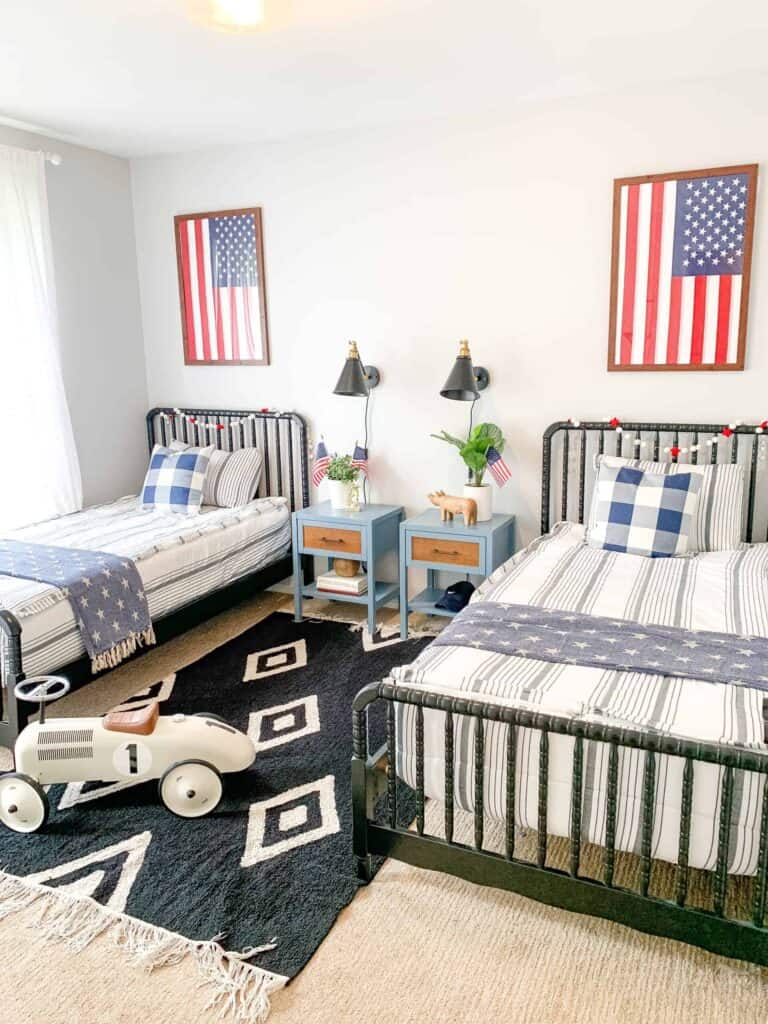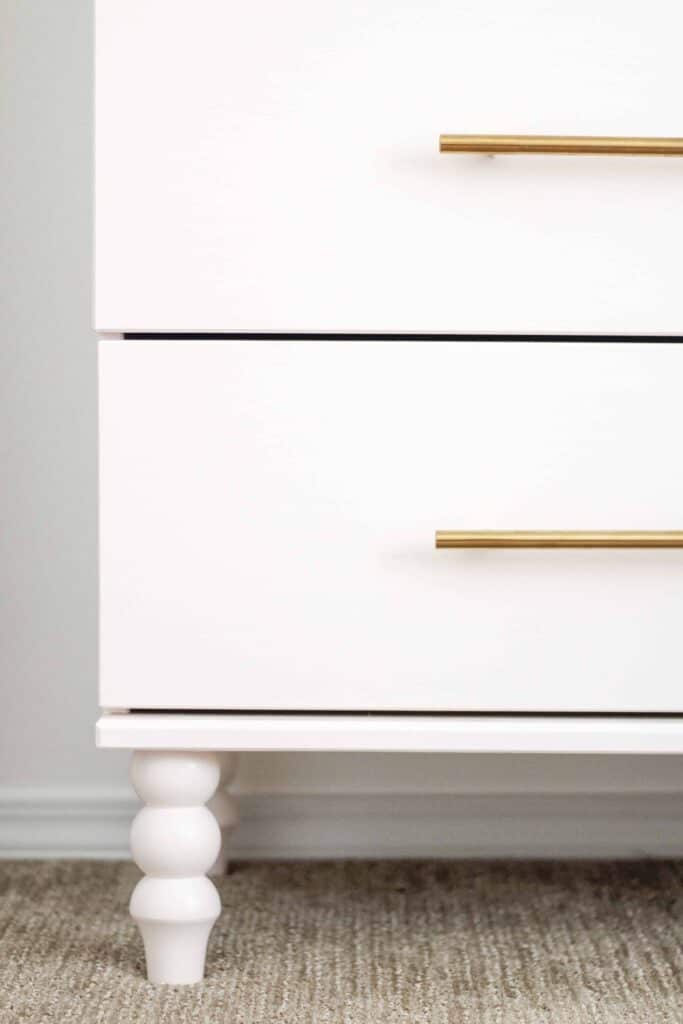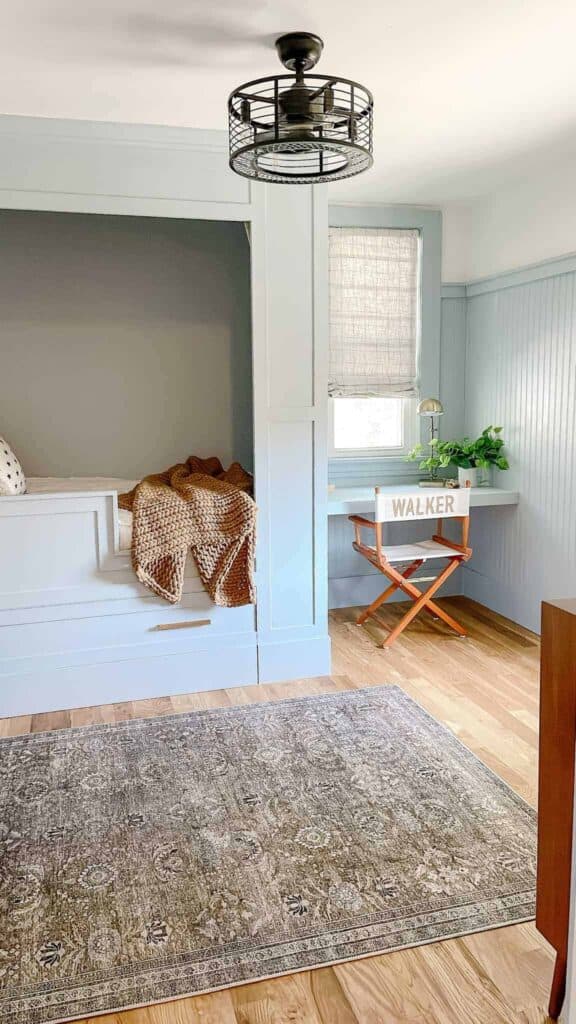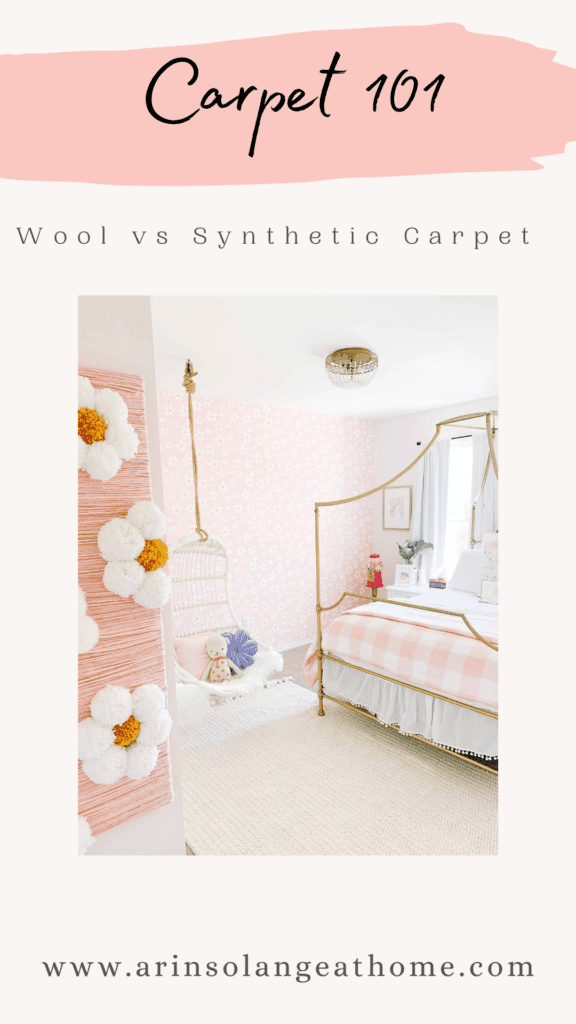Wool and synthetic carpets are two of the most popular types of flooring available today. Both offer a range of benefits, but there are some key differences between them that must be considered before making a purchase. Wool carpets offer more natural insulation, durability, and comfort than synthetic carpets, while synthetic carpeting tends to be more affordable and easier to clean. We’ll compare wool vs synthetic carpet and discuss the advantages and disadvantages of both materials so you can make the most informed decision when it comes time to buy.
This post may contain affiliate links.

Wool vs Synthetic Carpet: Which Is Right For You?
Wool is made from the fleece of sheep, while synthetics are created from chemicals and other synthetic materials. Because of this difference, natural wool carpets generally provide a softer feel than their synthetic counterparts. Wool also has natural insulating properties that make it easier for your feet to keep warm during the winter months.
Synthetic carpet fibers are durable and can be cleaned with a vacuum cleaner when needed without damaging the fiber itself or having to be replaced as often as wool rugs would need to be replaced due to washing by hand or machine. Wool fibers are more sensitive to heat and can become damaged by high temperatures. Because of this, you’ll need to take extra care when cleaning any wool carpets.
Fiber content matters when it comes to the best carpet for your home. For example, wool is a natural insulator which can make it more difficult to cool a room in the summer and warm in the winter. On the other hand, synthetics generally do not insulate so they are able to do equally well with both temperature extremes.
If you’re considering a purchase of new carpet for your home, understanding what materials are available should help you decide which one is best for your needs and budget. Wool vs synthetic carpet can really depend upon what is best for your family and lifestyle.

A Guide To Carpets
Carpets are a great way to add style and comfort to your home. They come in a variety of colors, textures, and materials. Thus, making it easy to find the perfect one for your space. This guide will provide an overview of the different types of carpets available and tips on how to choose the right one for you.
We’ll discuss everything from selecting the right material to taking care of your carpet once it’s installed. With this information, you’ll be able to make an informed decision when it comes time to purchase a carpet for your home.
Carpet Construction 101
Carpet construction is the process of constructing carpets from raw materials. It involves a variety of processes. These processes includes weaving, tufting, knotting and finishing. The process begins with selecting the right type of yarn and material for the desired look and feel. Once the yarn is selected, it is then woven into a backing fabric to form a carpet.
Next, additional components such as latex or foam are added for cushioning or extra comfort. Finally, finishes such as dyeing or printing are applied to create a unique design or pattern. Carpet construction requires skill and knowledge in order to produce quality carpets that last for years.
Types Of Carpet Construction
There are several types of carpet constructions. These include loop pile, level loop and multi-level. Each type has its own unique characteristics and benefits. It is important to understand these differences when selecting a carpet for your home.
Loop pile carpets are constructed with yarns that are formed into loops, resulting in a durable and resilient surface that is ideal for high traffic areas. Level loop carpets have yarns that are cut at even heights to create a uniform look across the entire carpet surface. Multi-level carpets combine both loop pile and level loop styles to create an interesting texture with depth and dimension.
Different types of carpets are made from different materials and constructed in different ways. As a result, you have a wide range of options to choose from. Cut pile carpets, one of the most popular types, comes in a variety of styles such as plush, textured, frieze, cable, and saxony.
Cut and loop carpets feature both cut fibers, which are tufted into a backing material, and uncut loops, resulting in interesting patterns. This type of carpet offers great durability and versatility. It is an excellent choice for any home or office space. Regardless of the carpet type, each has their own signature style helping you create the perfect atmosphere in any room.

Carpet Materials: Wool vs. Synthetic Carpet
Carpet is one of the most common floor coverings used in homes and businesses. It can be made from a variety of materials including nylon, olefin, acrylic, and wool. Each material has its own pros and cons when it comes to carpet construction. In this article, we will explore the different options when it comes to carpet construction and discuss the pros and cons of each. We will also look at some common uses of carpets so that you can make an informed decision when selecting a carpet for your home or business.
Nylon Carpet
Nylon carpet is one of the most common materials used in the construction of carpet. It is a synthetic fiber with a variety of applications in industrial and commercial settings. The material, when combined with other fibers, creates resilient, non-toxic flooring.
Furthermore, nylon carpet can stand up to high traffic without wearing down from friction or heat. Nylon carpets are durable and have low water absorption compared to wool carpets. This feature allows for quick drying time so that dirt does not become embedded into the carpet fibers.
Olefin Carpet
Olefin is one of the most popular options of carpet construction due to its durability and resistance to stains. It is made from polypropylene carpet fibers that are woven together into a strong and resilient material. Olefin carpets are also known for their ability to resist fading, making them ideal for high-traffic areas like hallways and family rooms. Understanding how olefin carpets are constructed can help you make an informed decision when selecting your new flooring.
Acrylic Carpet
Acrylic is another popular material used in carpet construction. It is strong, durable, and easy to clean, making it an ideal choice for high-traffic areas like living rooms and hallways. Acrylic carpets are also available in a variety of colors and patterns. This allows you the opportunity to customize your space according to your personal style.
Wool Carpet
Wool is the most common choice when it comes to natural fiber carpeting. It has been popular for centuries due to its durability and resilience. Wool carpets are naturally resistant to dirt and stains, making them ideal for high-traffic areas in homes or businesses.
Wool is a natural material that offers good insulation, helping to keep your home warm in winter months. Furthermore, wool carpets come in a variety of colors and textures, allowing you to find the perfect fit for your home and decor.

Picking The Right Carpet
Carpets have been around for centuries and have been used to decorate homes, offices, and other spaces. They provide many benefits such as insulation, acoustics, and softness that make them a great choice for home decor.
Carpets also provide a safe environment for children to play on as they are kid-friendly and can be easily cleaned. Additionally, carpets can add warmth to any room which can make it more inviting. The importance of carpets is undeniable. From providing insulation from cold floors to reducing noise levels or add ing softness to any space, carpets are multi-functional.
Considerations Before Purchasing Carpet
There are several considerations to take into account before you purchase a carpet. The type of fiber, material, pile, density and pad all play a role in determining the comfort and longevity of your carpet.
Depending on your needs and budget, you may want to opt for a high or low pile with different types of carpet fibers such as nylon or wool. Additionally, selecting the right density and padding can help enhance the softness of your carpet while also providing extra cushioning for walking on it. With these considerations in mind, you can make an informed decision about which type of carpet is best for your home.
Keep in mind cleaning and care instructions. You’ll need to determine if you need a carpet that is pet-friendly and easy to maintain. Or, do you want a carpet that is more luxurious and in a low-traffic area of your home?
The type of carpet you choose will depend on the needs of your family. For example, if you have young children or pets in your home, then a kid- or pet-friendly option may be best for you. If you have a lot of people coming in and out of your home, then a carpet designed for high foot traffic areas may be preferable.
The style and aesthetic of the carpet should also be taken into consideration when making your choice. You want something that will fit in with the overall look of your home while still being practical for everyday use. With these considerations in mind, you can make an informed decision about which type of carpet is best for your home.

Wool Carpet: Natural Fibers
Wool carpets offer more natural insulation than synthetic carpets. As a result, wool carpet will keep your home warmer in winter and cooler in the summer. It is a durable fiber that resists wear and tear well over time, while synthetic fiber carpets are prone to stretching or breaking down with use. This can make wool carpet a better investment for long-term use. Wool doesn’t produce any waste when it is worn out, which makes it more eco-friendly than synthetic materials.
Wool carpets come in a variety of colors, textures, and prices. They are fabricated from animal fibers such as sheep’s wool and goat’s hair. This superior quality is what gives it its natural insulating properties. Wool carpeting is durable and holds up well to wear and tear. The natural oils found in wool fibers help muffle sounds and provides the ultimate comfort.
Wool carpets also tend not to trap as much dust or allergens as synthetic carpet does, which makes them safer for young children.

Synthetic Carpet
Synthetic carpets are becoming increasingly popular due to their numerous advantages. They are cost-effective, durable, and easy to maintain, making them an ideal choice for any home or office. Furthermore, synthetic carpets come in a variety of colors and designs that can match any decor. They also boast excellent sound insulation and fire resistance properties that make them a great choice for noise reduction and safety. Finally, synthetic carpets are hypoallergenic and resistant to dust mites, making them a great option for those with allergies or asthma.
Synthetic carpets are installed very similarly to other types of carpet, with the exception of not having to cut the loops. The installation varies based on the type of looping system that is used, with the most common being a continuous loop.
A continuous loop features a single piece of nylon webbing that runs across the entire room and is secured at each end by a backing board. After laying down one or both ends of the carpet, an adhesive fastens it in place to your backing boards. You can then simply loop your nylon webbing around the backing boards and secure each end in place.
While using the continuous loop system, avoid placing any fasteners on top of or near a carpet loop as this can make it difficult to properly stretch the looping system. Also, be sure not to tightly grip the nylon webbing when stretching it across a backing board. If you do, this can cause areas of tension where loops might not be evenly spaced across your room. While you likely won’t make your own carpet, knowing how their made helps you determine quality products.

Wool vs. Synthetic Carpet
| Wool Carpet Pros | Synthetic Carpet Pros |
| – Natural fibre – Natural insulation – More durable – Eco-friendly – Requires hand washing or specialized cleaning – Ideal for allergy sufferers – Extremely soft and luxurious feeling | – Synthetic fibers – Cost effective – Easy to maintain – Flame retardant – Insulation benefits – Stain resistant and waterproof options – Popular choice for families – Hypoallergenic options |
Other Posts You May Like
Goldie’s Rainbow Nursery | Patriotic Boys Room | Daisy Wallpaper For A Girl’s Room
Follow On Social For The Latest & Greatest
Pin This Photo Below For Later
Wool and synthetic carpets are two popular options when it comes to floor coverings. Both have their own pros and cons, so it can be difficult to determine which is the better choice. In the long run, it comes down to personal preference. I hope this article has helped you weigh some of the pros and cons of wool vs synthetic carpet. No matter which choice you make, there will be many days to look forward to with the added coziness of the perfect carpet under your toes! Be sure to pin the photo below for later, and if you don’t already – follow me on Instagram (@arinsolange) and Tik Tok (@arinsolange) for more fun!







